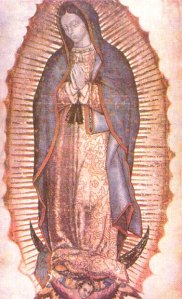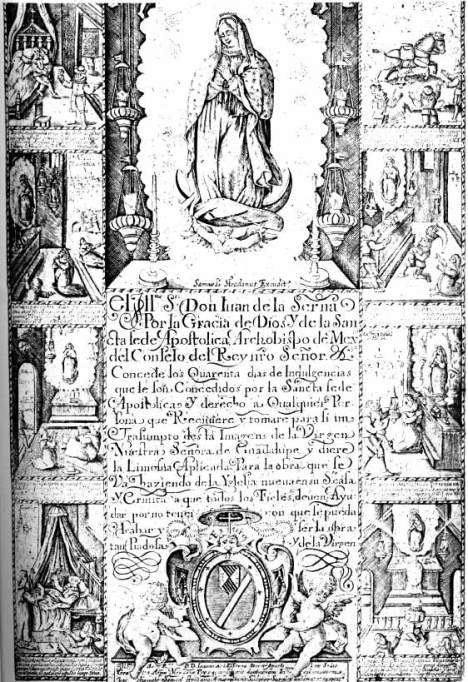 Sor María Antonia de la Purísima Concepción, 18th century, Ex Convento de Culhuacán (pictures), Mexico City. Click on the image to enlarge. The caption records her parents’ names, her birthdate, and the date and place she took the habit for the first time. As the picture indicates, by the time of its making the Virgen de Guadalupe had become an officially-approved icon for devout Catholics.
Sor María Antonia de la Purísima Concepción, 18th century, Ex Convento de Culhuacán (pictures), Mexico City. Click on the image to enlarge. The caption records her parents’ names, her birthdate, and the date and place she took the habit for the first time. As the picture indicates, by the time of its making the Virgen de Guadalupe had become an officially-approved icon for devout Catholics.
Image found here via a correspondent.
My source for this image was a recent visitor to this blog, and her kind e-mail, which mentioned in passing that entering a convent was a way for young women of mixed race to obtain a more-secure place in colonial Spanish America, has prompted me to pick up a loose end from my more recent posts on the Virgen de Guadalupe.
The loosest of those ends (for me) was how the Church reconciled the Virgen de Guadalupe’s association with the Immaculate Conception with her depiction as a mestiza, especially given the Church’s active role in the policing of racial hierarchies. That question begins to get answered via María Elena Martínez’s excellent book Genealogical Fictions: Limpieza de Sangre, Religion, and Gender in Colonial Mexico. Martínez notes that, whereas limpieza de sangre (“purity of blood”) originated in Spain during the Reconquista as a way of determining not race but a genealogy of religious affiliation (those who could demonstrate that their families had been Christians for at least three generations (unless someone in their family had been a Muslim) were thus eligible for the higher government and Church posts–as an aside, this explains why Cabeza de Vaca refers to himself and his fellow castaways not as Spaniards but as Christians), over time in the Americas the term came to indicate racial distinctions.
The existence of the Indians were the cause of this change in the term’s meaning. They were regarded as pure, but:
Ambiguities in the purity status of native people [. . .] emanated from the very contradictions of Spanish colonialism, from a political ideology that on the one hand announced that they were untainted because they lacked Jewish, Muslim and heretical antecedents and had willingly accepted the faith, and on the other constantly iterated that they would revert to idolatry if left to their own devices and in the hands of misguided leaders. (214)
These contradictions led as well to a lack of consistency among the different religious orders regarding how to think through this question. The Franciscans, for example, didn’t regard indigenous descent that was sufficiently distant in one’s past as a hindrance to determining one’s purity (and, thus, access to sinecures in the Church and government). But the Spanish-born and those born of Spanish parents in Mexico (read: those traditionally the only ones eligible for such positions) obviously did not agree with less-strict understandings of purity (Martínez, 219).
Enter both the genre of casta paintings and the rising prominence of the Virgen of Guadalupe.
Continue reading
Filed under: Americas, art, casta paintings, Colonial era, Iconography, mestizaje, Mexico, painting, Religion, Virgin of Guadalupe | Leave a comment »






 I want to return to this image for a moment, which I posted on
I want to return to this image for a moment, which I posted on 



